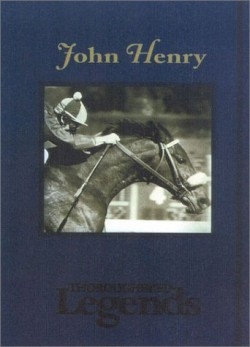John Henry
Thoroughbred Legends
Born with a leg deformity that suggested he might be better suited to a less strenuous way of life than the profession to which he was born, no one ever expected John Henry to amount to much.
For those who do not follow the sport of kings, John Henry is an ex-racehorse. Not just a “one race wonder,” either. John’s ability to keep on competing at the age of ten, when most horses are comfortably retired, made him a legend. Over the course of his career, the thoroughbred started eighty-three races and finished in the money (first, second or third place) sixty-three times, good for almost $6.5 million in winnings. Twice he was named Horse of the Year, and he was a seven-time winner of the Eclipse Award, given to the top male grass runner.
John Henry was born in 1975, the offspring of Once Double and Ole Bob Bowers. Add to the aforementioned physical abnormality his nasty disposition—he would often try to nip his handlers and was wont to destroy the metal tubs and buckets in his stall, reinforcing the image of his name, taken from the folk song about a “steel driving man”—and it’s no wonder that he was passed from owner to owner.
Fortunately he caught the eye of sportsman Sam Rubin, who discerned John Henry’s potential. He placed the horse under the guiding hand of Ron McAnally, who tells lovingly about the special relationship he shared with the high-spirited equine.
The book contains a few quirks. At one point, the author writes of an entourage of horse people—trainers, veterinarians, assorted handlers—including a “horse spiritualist” who “spoke” with John, intimating to the assembled that the horse “told” her that he understood that his main purpose was to serve his human masters. This alone could put a few readers off their feed.
John Henry is part of the “Thoroughbred Legends” series, which includes such well-known champions as Man O’ War, Citation, Seattle Slew, Forego, Native Dancer, Nashua, Spectacular Bid and Ruffian. One of the problems in a book such as this is the overuse of racing jargon, which might not be understood by the casual fan. A glossary of some sort would have been most appreciated.
Haskin, an award-winning horse writer and national correspondent for The Blood-Horse, the leading thoroughbred industry weekly, has managed to take an unusual topic—an animal biography—and turn it into an interesting, heart-warming story.
Reviewed by
Ron Kaplan
Disclosure: This article is not an endorsement, but a review. The publisher of this book provided free copies of the book to have their book reviewed by a professional reviewer. No fee was paid by the publisher for this review. Foreword Reviews only recommends books that we love. Foreword Magazine, Inc. is disclosing this in accordance with the Federal Trade Commission’s 16 CFR, Part 255.

